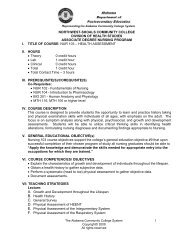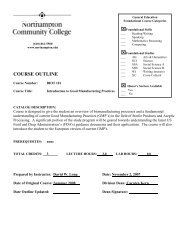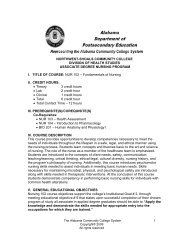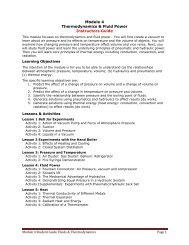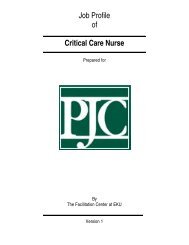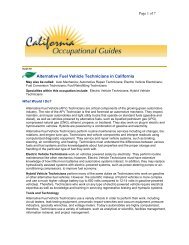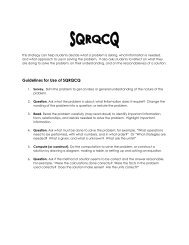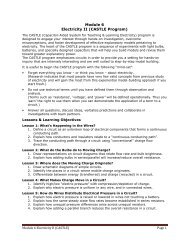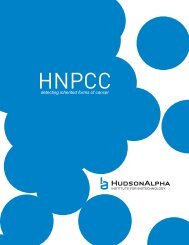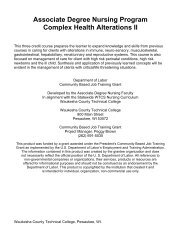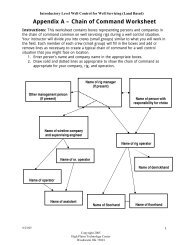CVS Handbook20pg.indd - Workforce 3 One
CVS Handbook20pg.indd - Workforce 3 One
CVS Handbook20pg.indd - Workforce 3 One
Create successful ePaper yourself
Turn your PDF publications into a flip-book with our unique Google optimized e-Paper software.
<strong>Workforce</strong> Initiatives<br />
Vision Statement<br />
To lead in the cutting-edge development of diverse employment, training,<br />
and education programs, establishing <strong>CVS</strong> Caremark as the distinguished<br />
model for innovative workforce initiatives.<br />
Mission Statement<br />
To hire, train, develop, retain, and support life-long learning of diverse<br />
qualifi ed associates, adding value to <strong>CVS</strong> Caremark by establishing<br />
partnerships with local, state, and federal agencies, educational<br />
institutions, non-profi ts, and faith-based organizations.<br />
<strong>CVS</strong> Caremark <strong>Workforce</strong> Initiatives Headquarters<br />
939 Route 146, Bldg. 600, Clifton Park NY 12065<br />
518-383-4517 x8012<br />
The Employer Handbook was developed by<br />
Lena Barkley<br />
Project Director, Career Prescriptions for Success<br />
Manager, <strong>Workforce</strong> Initiatives<br />
Markets in Michigan and Indiana<br />
Michelle Voll<br />
Deputy Director, Career Prescriptions for Success<br />
Consultant, <strong>Workforce</strong> Initiatives<br />
<strong>CVS</strong> Regional Learning Center<br />
5901 Conner Road<br />
Detroit, MI 48213<br />
313-267-4070<br />
For more information, please contact:<br />
Lena Barkley at lbarkley@cvs.com or 248-888-6341<br />
<strong>Workforce</strong><br />
Initiatives
The President’s High Growth<br />
Job Training Initiative Health Care Grant<br />
Career Prescriptions for Success (CAPS)<br />
Employer Handbook<br />
Funded by:<br />
U.S. Department of Labor<br />
Employment and Training Administration<br />
The President’s High Growth Job Training Initiative engages business, education,<br />
and the workforce investment system to develop solutions to the<br />
workforce challenges facing high-growth industries.<br />
Submitted by:<br />
<strong>Workforce</strong><br />
Initiatives<br />
2008
Acknowledgments ____________________________________________________________ 1<br />
<strong>Workforce</strong> Initiatives __________________________________________________________ 2<br />
Career Prescriptions for Success _______________________________________________ 2<br />
Program Outcomes and Benefits ________________________________________________ 2<br />
The Employer-Driven Apprenticeship Program ____________________________________ 3<br />
1. Develop Apprenticeship Standards with the U.S. Department of Labor ________________ 3<br />
2. Select the Right Leadership Team to Drive Your Program __________________________ 3<br />
3. Solicit the Support from Management at the Start of Your Initiative ___________________ 4<br />
4. Engage Faith-Based and Community Partners to Provide Pre-Employment Services and<br />
Retention Support ________________________________________________________ 4<br />
5. Create a Pathway to Employment Through Work Experience Opportunities ____________ 5<br />
6. Build a Career Ladder Through Registered Apprenticeship _________________________ 6<br />
7. Develop a Pipeline Through Lifelong Learning Opportunities _______________________ 8<br />
8. Replicate Your Pilot to Help Others in the Company Create the Program ______________ 9<br />
9. Win New Resources with the Results You Achieve _______________________________ 9<br />
Pursuing a Career in Pharmacy ________________________________________________ 10<br />
Advancing Her Career as a <strong>CVS</strong> Apprentice _______________________________________11<br />
Completing Industry Certifications in Pharmacy Technology _______________________ 12<br />
On the Fast Track to a Successful Management Career ____________________________ 13<br />
Appendix____________________________________________________________________ 14<br />
Chart 1: CAPS Program ____________________________________________________ 15<br />
Chart 2: Internship and Apprenticeship Model ___________________________________ 16<br />
Chart 3: <strong>CVS</strong> Career Ladder _________________________________________________ 18
“Our mission in <strong>Workforce</strong> Initiatives is to develop partnerships with<br />
organizations that can assist us in hiring good people. The CAPS<br />
program has been an excellent model for that mission. After the great<br />
success we have had in Detroit, hiring excellent store employees<br />
and training them for career path opportunities, we want to make this<br />
opportunity available nationwide. It works and it shows that partnerships<br />
can be very valuable in developing a strong store team. ”<br />
—Steve Wing, Director, <strong>Workforce</strong> Initiatives<br />
Acknowledgments<br />
Career Prescriptions for Success (CAPS) would not have been possible without the countless<br />
hours spent by district managers, pharmacy supervisors, pharmacists, store managers, and<br />
trainers. We thank everyone for mentoring the CAPS apprentices and helping these <strong>CVS</strong><br />
employees advance their careers. We also give special recognition to regional managers and<br />
HR business partners for making this project a success.<br />
Many thanks to the following <strong>CVS</strong> <strong>Workforce</strong> Initiatives Managers for replicating the Detroit CAPS<br />
pilot model in the following four cities:<br />
Atlanta, Mike Romesburg<br />
Chicago, Leori Moore<br />
Dallas, Irvine Porter<br />
Indianapolis, Lena Barkley<br />
We recognize the valuable contributions of all the project partners and give special thanks to the<br />
following people and organizations:<br />
Diane Burroughs, Executive Assistant<br />
William Wubbenhorst and the Team at<br />
Macro International Inc.<br />
Consulting Services for<br />
Community Solutions<br />
Detroit <strong>Workforce</strong><br />
Development Department<br />
Goodwill Industries of<br />
Greater Detroit<br />
Holy Ghost and Fire Deliverance<br />
Church of God in Christ<br />
Michigan Works!<br />
National Retail Federation Foundation<br />
Operation ABLE<br />
Partnerships for Economic Independence<br />
Wayne County Community College District<br />
Wayne State University<br />
1
<strong>Workforce</strong> Initiatives<br />
<strong>CVS</strong>/pharmacy, the retail division of <strong>CVS</strong> Caremark Corporation, is America’s largest retail pharmacy with more than 6,300 retail locations. It is<br />
committed to improving the lives of those it serves by making innovative and high-quality health and pharmacy services safe, affordable, and easy<br />
to access, both in its stores and online at <strong>CVS</strong>.com.<br />
To meet business growth and retention of its associates and to ensure high-quality service to customers, <strong>CVS</strong> used an innovative strategy through<br />
its <strong>CVS</strong> <strong>Workforce</strong> Initiatives Department. <strong>CVS</strong> started its fi rst Welfare-to-Work training program in 1996. Retention of the associates hired<br />
through the program has been twice as high as those hired through more traditional methods, which represents a stark contrast to other entrylevel<br />
service jobs in retail, where turnover can easily exceed 200 percent a year. Additionally, over half of the former welfare recipients who have<br />
come through customized training programs have been promoted at least twice.<br />
The priority <strong>CVS</strong> gives to workforce and community partnerships is embodied in its <strong>Workforce</strong> Initiatives team that works with national, state,<br />
local government agencies, educational institutions, and faith-based and community organizations across the country. <strong>CVS</strong> has partnered with a<br />
number of markets to establish Regional Learning Centers, which offer training at several points along a career path leading from entry-level jobs<br />
to higher-paying career positions. Many of these facilities include freestanding prototype “mock stores” that allow for training individuals at entrylevel<br />
retail jobs, photo positions, or with further training, to become pharmacy technicians.<br />
Career Prescriptions for Success<br />
Given the needs of an aging population and the greater use of medication, employment of pharmacy technicians is expected to grow faster than<br />
average for all occupations through 2012. Since the number of degrees granted in pharmacy is expected to be fewer than the number of job<br />
openings created by retiring pharmacists, a shortfall of 157,000 pharmacists is projected by 2020.<br />
<strong>CVS</strong>/pharmacy is addressing this nationwide shortfall of high demand occupations through Career Prescriptions for Success (CAPS)—a U.S.<br />
Department of Labor (USDOL) Registered Apprenticeship program in pharmacy. Funded with a health care grant from the President’s High<br />
Growth Job Training Initiative (HGJTI) of USDOL competitively won in 2005, the CAPS program was piloted in Detroit and replicated in four other<br />
cities over 3 years. The CAPS team developed the following multipronged career path strategy:<br />
1.<br />
2.<br />
3.<br />
4.<br />
5.<br />
6.<br />
Build community interest in pharmacy careers.<br />
Target recruitment in high-unemployment neighborhoods.<br />
Provide paid apprenticeships for pharmacy associate and technician occupations.<br />
Assist incumbent workers with removing career barriers to become pharmacy technicians.<br />
Advance workers through 2- and 4-year academic programs.<br />
Provide technical assistance to replicate the Detroit model in Chicago, Indianapolis, Atlanta, and Dallas, followed by national replication<br />
after the end of the Federal grant.<br />
Program Outcomes and Benefits<br />
The <strong>CVS</strong> Caremark vision is to be a cutting-edge leader in diverse employment, training, and education programs. The <strong>Workforce</strong> Initiatives<br />
department of <strong>CVS</strong> exceeded outcomes numbers for its HGJTI grant, with higher retention rates found among apprentices than among nonapprentices<br />
in the Detroit market. Apprentices came from diverse backgrounds and many had previously experienced employment barriers.<br />
Measures Grant Goals Outcomes<br />
# of Candidates in Pre-Employment Training 100 651<br />
# of <strong>CVS</strong> Interns 90 185<br />
# of Apprentices in Detroit Pilot Site 80 96<br />
# of Apprentices in Four Replication Sites Not Specifi ed 134<br />
# of Incumbents 130 130<br />
# of Employees in Continuing/Higher Education 20 62<br />
<strong>CVS</strong> and its project partners were able to provide matching training and in-kind resources equivalent to the 1.7 million dollar grant received from<br />
the Federal Government. The benefi ts of the CAPS program can be summarized as follows:<br />
1. Faith-based and community organizations (FBCOs) provided pre-employment training and post-placement retention support.<br />
2. Store Managers were able to hire apprentices from a highly screened and qualifi ed pool of candidates.<br />
3. USDOL Registered Apprenticeship offered a competitive credential in pharmacy technology to <strong>CVS</strong> workers.<br />
4. The partnership with the public workforce system, community college, and institution of higher education created a new education<br />
career pathway and internal pipeline for the development of future pharmacists.<br />
5. Motivated and trained employees are known to increase productivity and profi tability.<br />
6. Higher retention rates reduce the company’s cost of recruitment, hiring, and training.<br />
7. Marketing of apprenticeship and education opportunities improve local community relations and provide access to a new customer base<br />
in neighborhoods where stores are located.<br />
2
The Employer-Driven Apprenticeship Program<br />
This handbook tells the story of CAPS with a step-by-step description of how to develop<br />
an employer-driven apprenticeship program. It offers key factors and lessons learned,<br />
followed by a sampling of apprentices’ success stories. Every one of our 96 apprentices<br />
has a similar story to tell. Every one of them is a success story.<br />
1<br />
Develop Apprenticeship Standards with the<br />
U.S. Department of Labor<br />
The fi rst step is to assess your training program to determine if you are ready to take the<br />
next step to create a career ladder that will give your employees an industry-recognized<br />
certifi cation and a portable, nationally registered apprenticeship credential.<br />
An employer or a group of employers who are interested in creating a registered<br />
apprenticeship program should meet with a fi eld liaison from the USDOL Offi ce of<br />
Apprenticeship. The fi eld liaison will provide technical consultation services on the<br />
development of apprenticeship standards. To locate a fi eld offi ce at the state or regional<br />
level, go to http://www.doleta.gov/OA or call the national offi ce at (202) 693-2796.<br />
The process of setting up a program involves registering the apprenticeship track under a<br />
set of standards, which include on-the-job training modules, related classroom instruction<br />
curricula, and operating procedures. Since <strong>CVS</strong> is a national employer, the company wanted<br />
to develop national standards that could be used by any of its stores nationwide.<br />
With the Offi ce of Apprenticeship, <strong>CVS</strong> created a set of documents that can be used as<br />
a template by any <strong>CVS</strong> Regional Business Offi ce to register the apprenticeship program<br />
with the corresponding USDOL fi eld offi ce. Wage rates and age eligibility may need to be<br />
adjusted in different markets.<br />
2<br />
Select the Right Leadership Team to<br />
Drive Your Program<br />
When you set up the registered apprenticeship program, the best team you can constitute will<br />
have experience in working with the business’s fi eld operations and human resources (HR)<br />
as well as with workforce initiatives and government programs. For the <strong>CVS</strong> initiative, the<br />
project director played a critical role.<br />
District Manager Cliff Riley commented: Lena [Barkley] brings a passion to the entire<br />
mission, not just the program. She has a heart and a passion for people. This made it easier<br />
to get the buy-in from management. I think she has been the total driver in this program from<br />
both the corporate level, from the governmental level, as well as the store level.<br />
An Apprenticeship Advisory Committee guided the program and was constituted by<br />
stakeholders from management, human resources, and educational institutions. The project<br />
also employed a coordinator to work with the FBCO service providers. The coordinator<br />
provided technical assistance on program development, service delivery, and outcomes<br />
measurement. This collaborative experience enhanced <strong>CVS</strong>’s ability to work with service<br />
providers.<br />
3
3<br />
Solicit the Support from Management at the<br />
Start of Your Initiative<br />
A key success factor is to engage the HR business partners and regional managers at the<br />
beginning of your project. It is also important to have a clearly defi ned program structure—as<br />
outlined below—before involving other project partners.<br />
• Illustrate the process of how candidates are referred.<br />
• Show what pre-employment services and training will be offered.<br />
• Demonstrate what support resources are provided by the collaboration.<br />
• Create a clear fl ow of communication among all parties.<br />
• Demonstrate how this program will impact retention rates.<br />
The CAPS model and structure was being developed while the faith-based and community<br />
service providers were recruiting potential candidates, providing pre-employment services,<br />
and referring individuals to <strong>CVS</strong>. In retrospect, the project team should have spent more<br />
time upfront, solidifying the structure of the program with HR and management. Defi ning the<br />
structure of the program while it was in progress was challenging at times; it took the team<br />
close to 1 year to streamline the process.<br />
When the HR managers became directly engaged in the program, the project director was<br />
able to generate the necessary support from fi eld operations. According to HR Managers<br />
Steve Watkins and Wayne Melton in Detroit, the hiring, placement, and training of apprentices<br />
was coordinated more effectively once district managers and pharmacy supervisors bought<br />
into the program and communicated what was needed at the store level.<br />
To obtain the buy-in from store managers, it was key that CAPS offered a payroll incentive.<br />
Offering to managers a wage subsidy that could be used toward the initial classroom training<br />
and on-the-job-learning made them more willing to participate in the program.<br />
4<br />
Engage Faith-Based and Community Partners<br />
to Provide Pre-Employment Services and<br />
Retention Support<br />
The business partnership needs to generate value for each partner involved. Ask the<br />
following two key questions: (1) What qualifi cations, capabilities, and services does the faithbased,<br />
community, or workforce agency have to offer to my business? (2) What opportunities<br />
and resources do I have to offer to these partners? Agencies that want to partner with<br />
employers need to—<br />
• Understand the signifi cance of organizational culture;<br />
• Emphasize employer considerations;<br />
• Build—and not break—the employer’s trust;<br />
• Drive the employer’s bottom-line services; and<br />
• Maximize opportunities to meet the employers’ needs.<br />
To recruit candidates and provide pre-employment services, <strong>CVS</strong> partnered with Goodwill<br />
Industries of Greater Detroit, Partnerships for Economic Independence, Operation ABLE,<br />
Holy Ghost and Fire Deliverance Church of God in Christ, and Michigan Works <strong>One</strong>-Stop<br />
Career Centers. Once apprentices were hired, these organizations also provided postplacement<br />
retention support to apprentices. <strong>CVS</strong> partnered with each of these agency and<br />
with Wayne County Community College District to conduct job fairs, community health fairs,<br />
and informational sessions on careers in pharmacy.<br />
A solid pre-employment training program includes intake, screening, assessment, coaching,<br />
work identity formation, soft skills training, academic preparation, transitional employment, job<br />
development and placement, retention, and post-placement support.<br />
The CAPS service providers incorporated these components to varying degrees. At opposite<br />
spectrums of organizational size and type were Goodwill Industries of Greater Detroit as a<br />
4
large community organization, and Holy Ghost and Fire Deliverance Church as a grassroots<br />
church. What they both shared were pre-employment programs that produced results.<br />
Both programs helped individuals become job-ready who otherwise would not have been<br />
employed by <strong>CVS</strong>.<br />
The following two key factors made the partnership with Goodwill Industries innovative:<br />
(1) The Goodwill program was guided by a Business Advisory Council and employer<br />
members worked with Goodwill staff to develop pre-employment skill training that was<br />
customized to various industry needs. (2) Goodwill coaches followed an effective case<br />
management system that included active retention support of program participants for up<br />
to 1 year after job placement.<br />
Key Success Factors: FBCO Collaboration<br />
1. Service Provider staff provides a nurturing environment to candidates.<br />
2. Direct involvement of and interaction with the FBCO leadership.<br />
3.<br />
4.<br />
Inclusion of <strong>CVS</strong> training modules in the FBCOs’ pre-employment curriculum helping<br />
candidates be better prepared.<br />
Customizing the employability skill development according to the candidate’s<br />
strengths and weaknesses.<br />
5. Collaborative relationship and communication about suitable work environment for the<br />
candidate (e.g., fast-paced versus slower retail sales or higher versus lower volume of<br />
scripts in pharmacy).<br />
6. Provision of consistent case management and ongoing retention support.<br />
5<br />
Create a Pathway to Employment Through<br />
Work Experience Opportunities<br />
Pairing transitional employment, work experience opportunities, and internships with<br />
employability skills training is an effective strategy for long-term employment.<br />
Goodwill Industries provided the most extensive pre-employment program with 6 weeks of<br />
intensive service training and work experience opportunities. The Goodwill candidates came<br />
from fi ve Temporary Assistance for Needy Families (TANF) agencies. Each candidate was<br />
given a customized plan for success, a targeted employment outcome, and the support of a<br />
coach along the way.<br />
Once candidates were referred to <strong>CVS</strong>, they enrolled in a 2-week internship program. The<br />
internship component gave store managers the opportunity to hire apprentices from a prescreened<br />
qualifi ed pool of candidates. An important lesson learned was that unlike the<br />
project team’s original estimates at the start of the grant, only one out of seven candidates<br />
ended up being qualifi ed for employment with <strong>CVS</strong>. It took far more resources than<br />
anticipated to provide pre-employment services and screening.<br />
Candidates from diverse backgrounds, who otherwise may not have had the opportunity<br />
to do so, were able to obtain employment with <strong>CVS</strong>. Many of these candidates were<br />
considered chronically unemployed and underemployed individuals with numerous barriers to<br />
employment. Goodwill Industries defi nes the “chronically unemployed” as persons who are<br />
more than one time TANF recipients and have lived with generational poverty.<br />
In an interview, Pharmacy Supervisor Bilal Bazzi commented: The sense of urgency to<br />
succeed for them is much higher than a typical candidate. For some, it’s their absolute last<br />
chance. The least thing we can do is to offer them support…we do challenge people in every<br />
way to bring out the best in them. We are not just trying to be a demanding company; we are<br />
a successful company.<br />
5
Pharmacy Supervisor Bilal<br />
Bazzi and his pharmacy staff<br />
Rajeev Sharma and Ella<br />
Savisch have mentored many<br />
CAPS apprentices.<br />
6<br />
Build a Career Ladder Through<br />
Registered Apprenticeship<br />
Career advancement opportunities are more readily available in large businesses. Small<br />
companies may need to look externally and partner with other businesses in their industries<br />
to build successful career ladders for employees. Turnover rates are lower and retention<br />
rates are better when workers are given the opportunity to improve their skills and can move<br />
along a clearly defi ned career ladder.<br />
<strong>CVS</strong> recognized that Registered Apprenticeship provides a structured training program to<br />
maintain the high level of skill and competence needed in its pharmacy industry. By creating<br />
workforce partnerships and investing in training, <strong>CVS</strong> has been able to achieve turnover<br />
rates that are lower than those of other retail businesses.<br />
<strong>CVS</strong> developed its own training curriculum. Classroom instruction was provided by trainers<br />
at the <strong>CVS</strong> Regional Learning Center in Detroit, located on the Eastern campus of Wayne<br />
County Community College District.<br />
Pharmacist Darnell Jones commented: I like the regional learning center because of the fact<br />
that it gives people the best of both worlds. Number one, you have the ivory tower vacuum<br />
effect. People are in a learning environment and they are not distracted. The learning center<br />
also has done a fantastic job replicating everything that people need to know once they get<br />
into a store setting. You actually have a mock store in the learning center. I’m going to go on<br />
record as saying that <strong>CVS</strong> has the best training program of any retailer I’ve ever seen in my<br />
life. They literally amaze me with how well they manage to train people before they get into<br />
the work environment.<br />
Pharmacist-in-Charge Nina<br />
Patel poses with Project<br />
Director Lena Barkley. Patel<br />
has provided a nurturing<br />
environment for CAPS<br />
apprentices in her training<br />
store.<br />
6
The on-the-job training component of the apprenticeship program was conducted in the<br />
pharmacy at either special training stores or stores where the apprentices were employed.<br />
Apprentices were broadly trained in all aspects of their job. Apprentices received systematic<br />
work experience in all areas of their responsibilities under the direction of a professional<br />
mentor.<br />
HR Business Partner Steve Watkins commented: We have training stores that do a really<br />
good job. The CAPS project director continuously utilized these stores. We want to retain as<br />
many people as we can and help them be successful.<br />
Lead Technician Connie Sims<br />
(right) mentored Heather<br />
Ramsey and other CAPS<br />
apprentices.<br />
Recognizing that on-the-job professional mentors are the key to the transfer of knowledge<br />
from the master to the apprentice, great care was exercised in selecting mentors to train<br />
each apprentice. The apprentices’ mentors were seasoned pharmacy technician trainers and<br />
pharmacists.<br />
The <strong>CVS</strong> career pathway was structured over a 2-year training period. Apprentices<br />
completed training modules that constituted three levels of industry certifi cations for the<br />
positions of Pharmacy Service Associate (Level I), Pharmacy Technician (Level II), and Lead<br />
Technician (Level III).<br />
By the end of the grant, most apprentices were certifi ed at Level I and Level II. All<br />
apprentices will continue to complete Level III certifi cation. After 2,000 hours of classroom<br />
instruction and on-the-job training, <strong>CVS</strong> technicians receive a nationally recognized, portable<br />
apprenticeship credential from USDOL.<br />
District Manager Dave Peterson provided the following perspective: We want to be able to<br />
identify ourselves as leaders in health care, and one of the things that we can do is to partner<br />
with the Government. I think we have a responsibility not only to the communities we serve<br />
but to the Government.<br />
Pharmacy Supervisor Bilal Bazzi added: We are sending the message that <strong>CVS</strong> is a<br />
responsible corporate citizen and is giving back to the community. When you consider<br />
partnering with DOL—it’s all about helping people fi nd jobs and be successful.<br />
7
7<br />
Develop a Pipeline Through Lifelong<br />
Learning Opportunities<br />
Employers can greatly benefi t from partnerships with their local workforce board, community<br />
college, and institution of higher education. By providing opportunities to employees to<br />
advance their education, employers can create a pipeline of workers for technical and<br />
professional jobs.<br />
The CAPS program assisted incumbent workers faced with barriers to career advancement in<br />
pharmacy. By conducting assessment surveys and interviews with managers and incumbent<br />
workers, the CAPS project team identifi ed incumbent workers who wanted to improve their<br />
customer service skills and/or were eager to continue their education if given the fi nancial<br />
assistance.<br />
To assist those incumbents interested in strengthening their customer service skills, <strong>CVS</strong><br />
partnered with the National Retail Federation Foundation (NRFF) to offer a preparatory<br />
course for the national customer service certifi cation exam. Incumbents fi rst took a retail<br />
readiness assessment and then the preparatory course followed by the certifi cation exam.<br />
The CAPS project team was able to adopt and modify the customer service skill development<br />
curriculum of the NRFF to better accommodate the schedules of <strong>CVS</strong> managers and<br />
incumbent workers. Shortening the curriculum was a key success factor, given that the<br />
full-length curriculum would not have been realistic for incumbents to complete. Both <strong>CVS</strong><br />
technician trainers and key staff from the faith-based and community partners participated in<br />
train-the-trainer workshops conducted by NRFF and were certifi ed to train in the extended<br />
and modifi ed curriculum.<br />
CAPS gave scholarships to pharmacy staff to attend Wayne County Community College<br />
and Wayne State University, which houses the Eugene Applebaum College of Pharmacy<br />
and Health Sciences. To qualify for scholarship funding, <strong>CVS</strong> incumbents needed to obtain<br />
a letter of recommendation from their pharmacy supervisor, be in good academic standing,<br />
and demonstrate commitment to pursuing a career in pharmacy. The scholarships helped<br />
Mayada Dabajeh make ends meet and complete her pre-pharmacy degree.<br />
She commented: I’ve always wanted to be a pharmacist, but school is very expensive; and<br />
the CAPS scholarship helped me to complete my studies for pre-pharmacy. Since I didn’t<br />
get into the Pharmacy Doctoral program, I’m now working on getting my bachelor’s degree in<br />
clinical pharmacy, to position myself better next time I apply. I am only able to work part-time,<br />
and my pharmacy manager is very fl exible in working my schedule around my classes.<br />
CAPS created a new education career path by fostering a strong partnership between<br />
<strong>CVS</strong>/pharmacy, the Detroit <strong>Workforce</strong> Development Department (administrative body for<br />
<strong>Workforce</strong> Investment Board), Wayne County Community College District, and Wayne State<br />
University. The partners committed themselves to sustain this education career path to meet<br />
the high demand for pharmacy technicians and pharmacists in Detroit and statewide.<br />
Sonia Ross, an incumbent now in her second term studying pre-pharmacy at Wayne County<br />
Community College District with CAPS scholarship funding, says that the opportunity to<br />
return to school gave her a renewed sense of hope for her career.<br />
She said: It means a lot to me that <strong>CVS</strong> is investing in my future. I attended Wayne County<br />
Community College District 10 years ago, but with raising a family and the costs, I couldn’t keep<br />
it up. I’ve been working in the pharmacy as a tech for 6 years and was beginning to feel a little<br />
stuck. Now, with my kids older and with the financial support from the CAPS program, I have<br />
an opportunity to pursue a degree and can see a future for myself where I hadn’t before.<br />
8
A signifi cant fi nding of the CAPS initiative in Detroit was that <strong>CVS</strong> managers had not realized<br />
the extent to which incumbent workers at the technician level are interested in becoming<br />
pharmacists if given the opportunity to enroll in continuing and higher education. The new<br />
educational path enabled workers to pursue lifelong learning and career advancement. While<br />
leveraging funding from the workforce system, <strong>CVS</strong> management is also assessing how it<br />
can make more corporate tuition assistance available to build an internal pipeline for the<br />
development of future pharmacists.<br />
District Manager Cliff Riley said: My biggest takeaway is that sometimes we do not invest<br />
the time to consider employees’ potential and fi nd out what their interests and talents are…<br />
We need to make sure that we are capitalizing on all the talents in our stores.<br />
8<br />
Replicate Your Pilot to Help Others<br />
in the Company Create the Program<br />
Once you have invested in a team that has created a successful pilot, use their capabilities<br />
and expertise to build the knowledge and capacity of others in the company to replicate the<br />
results.<br />
The CAPS director and deputy provided technical assistance to <strong>CVS</strong> <strong>Workforce</strong> Initiatives<br />
and Human Resource staff in Atlanta, Chicago, Dallas, and Indianapolis based on their<br />
experience in the pilot site. The Detroit team was able to assist the <strong>CVS</strong> apprenticeship<br />
managers in these cities to replicate the program by helping them understand how to—<br />
1. Set up an Apprenticeship Advisory Committee with the needed stakeholders;<br />
2. Work with the USDOL Employment and Training Administration (ETA) Regional<br />
Offi ces responsible for registering apprenticeship programs in their respective<br />
regions;<br />
3. Conduct labor market analysis to assess and meet affi rmative action requirements in<br />
each region;<br />
4. Make necessary changes to wage rates or selection criteria in adopting the national<br />
apprenticeship standards and work processes to the local area; and<br />
5. Enter demographic, training, and certifi cation data in the national USDOL database<br />
for registered apprenticeship programs.<br />
9<br />
Win New Resources with the Results You Achieve<br />
It’s important to develop a reliable outcomes measurement system and regularly report the<br />
results you achieve to the funding agency. Make sure you capture success stories and<br />
develop products useful to others. The results you achieve and the partnerships you develop<br />
can be leveraged to acquire new funding.<br />
The partnership developed between <strong>CVS</strong>/pharmacy, Goodwill Industries of Greater Detroit,<br />
Detroit <strong>Workforce</strong> Development Department, and Wayne County Community College<br />
District enabled the partners to win a new grant from USDOL under the Community-Based<br />
Job Training Initiative. With this new funding, <strong>CVS</strong> will extend CAPS to develop a training<br />
curriculum and national apprenticeship standards in retail management.<br />
The new project focuses on creating certifi cation and degree programs at Wayne County<br />
Community College District, and integrating the programs with the <strong>CVS</strong> apprenticeship<br />
program to give incumbent workers’ college credit for on-the-job-training. Other employers<br />
are also participating in this new project; <strong>CVS</strong> will be able to assist in building their capacity<br />
through the experience it gained with CAPS.<br />
9
SUCCESS STORIES<br />
Apprentice Dorcas Hamilton with Pharmacist David Rizzi and Project Director Lena Barkley.<br />
Pursuing a Career in Pharmacy<br />
Dorcas Hamilton was hired by <strong>CVS</strong> in September 2007 after completing the pre-employment<br />
training with Goodwill Industries of Greater Detroit.<br />
Since then, Dorcas received her Level I Apprenticeship Certifi cate for Pharmacy Service<br />
Associate from the U.S. Department of Labor and recently was certifi ed by <strong>CVS</strong> as a<br />
Pharmacy Technician.<br />
She says her experience with the CAPS program has been very positive: Everybody is<br />
willing and able to help you. And if you need assistance, don’t be afraid to ask because they<br />
defi nitely will be there for you, especially Lena [Barkley, Project Director] and Dave [Rizzi,<br />
Pharmacist].<br />
Hamilton graduated valedictorian from California Paramedical Technical College in Riverside,<br />
California, from which she obtained a certifi cate in pharmacy technology. While continuing<br />
to work at <strong>CVS</strong>, her next step will be to enroll at Wayne County Community College District<br />
to obtain her Associate Degree in Applied Science. Her long-term goal is to become a<br />
pharmacist.<br />
The CAPS apprentice has the following advice for other young people interested in pursuing<br />
a pharmacy career, “Don’t be afraid to go after what you really want.”<br />
10
Advancing Her Career as a <strong>CVS</strong> Apprentice<br />
Ty-Kisha Jefferson joined <strong>CVS</strong>/pharmacy as a CAPS apprentice in September 2006. She<br />
had worked in a restaurant for 5 years and felt discouraged from some of her experiences in<br />
that industry.<br />
Ty-Kisha enrolled in the 6-week pre-employment program with Goodwill Industries of Greater<br />
Detroit. As a single mom, Ty-Kisha faces a challenging schedule. She is raising her three<br />
girls, aged 10, 14, and 16, plus her sister’s three children—whom she adopted after her sister<br />
passed away.<br />
While in the Goodwill program, Ty-Kisha participated in workshops Mondays through<br />
Thursdays for 6 hours daily, followed by her shift work at Kentucky Fried Chicken until 1 or<br />
2 a.m. On Fridays and Saturdays she attended classes at Wayne County Community<br />
College District, followed again by her evening work shifts.<br />
Now, at <strong>CVS</strong> Ty-Kisha is working in a store located close to her home, which eases her busy<br />
parenting schedule. She continues to pursue an Applied Science degree while completing<br />
her 2,000 hours of apprenticeship training. Ty-Kisha already has received industry<br />
certifi cations as Pharmacy Service Associate and Pharmacy Technician. She is exploring<br />
whether to enroll at Wayne State University and become a pharmacist.<br />
Apprentice Ty-Kisha Jefferson with Pharmacist Emeka Izueghunam.<br />
SUCCESS STORIES<br />
11
SUCCESS STORIES<br />
Apprentice Tracy Moffett helps prepare a prescription.<br />
Completing Industry Certifications in<br />
Pharmacy Technology<br />
Tracy Moffett joined <strong>CVS</strong>/pharmacy as a CAPS apprentice in March 2007. Goodwill<br />
Industries of Greater Detroit referred Tracy after she completed the pre-employment training<br />
program.<br />
Previously certifi ed as a nurse assistant, Tracy had been interested in the medical fi eld for a<br />
long time. She is now completing the 2,000 hours of apprenticeship training with <strong>CVS</strong> and<br />
has already received industry certifi cations as Pharmacy Service Associate and Pharmacy<br />
Technician.<br />
Tracy is a student at Wayne State University. She is trying to decide whether to pursue prepharmacy<br />
as her major.<br />
Tracy commented on the CAPS apprenticeship training: The program is very benefi cial and<br />
I like the fact that the hours are fl exible. I’m a single parent, and fl exibility is important to<br />
me. The people I work with are helpful and don’t hold you back from learning. They let you<br />
experience all parts of the pharmacy.<br />
Tracy compared the work environment to a family atmosphere, “We all help each other out.<br />
Everybody is on the same level no matter what their education or background is; and we all<br />
work well together.”<br />
12
On the Fast Track to a Successful Management Career<br />
Teresa Riggins learned about the <strong>CVS</strong> CAPS program through Goodwill Industries, where she<br />
completed the pre-employment program. Teresa joined <strong>CVS</strong> as an apprentice in August 2006.<br />
Before joining <strong>CVS</strong>, Teresa was looking for a challenging job in a new field, with advancement<br />
opportunities. Since her enrollment, Teresa has excelled and obtained industry certifications<br />
as Pharmacy Service Associate and Pharmacy Technician.<br />
Her mentor, Pharmacist-in-Charge Darnell Jones, very quickly identified her as a “fast-track<br />
employee.” He encouraged her to consider a career in retail management. He could see from<br />
day 1 that she had supervisory talent. Within a short time, Teresa became shift supervisor and<br />
then assistant store manager.<br />
Regional Manager Mark Hall was greatly impressed with Teresa’s outstanding people skills<br />
and dedication to customer service. According to Darnell, “Even though she [Teresa] had<br />
been there the least amount of time, she was the one that customers were relating to the<br />
most. Mark Hall was completely blown away by how she was interacting with him and the<br />
customers.”<br />
Darnell commented: The biggest lesson I have learned from the CAPS program is that we<br />
should never make any assumptions about where a person is at in their life and what they<br />
can contribute. Now it is just a matter of time and Teresa will be a store manager.<br />
Teresa is the mother of two young sons and is pregnant with her third child. She and her<br />
husband also just bought their own business—the child day care center where their children<br />
attend.<br />
Apprentice Teresa Riggins with Pharmacist Darnell Jones.<br />
SUCCESS STORIES<br />
13
Appendix<br />
Chart 1: CAPS Program<br />
Chart 2: Internship and Apprenticeship Model<br />
Chart 3: <strong>CVS</strong> Career Ladder<br />
14
Chart 1: CAPS Program<br />
Activities Flowchart<br />
M2<br />
FBCO: Peer Support Groups Led by Mentors<br />
Q1<br />
M1<br />
FBCO:<br />
Recruit<br />
unemployed or<br />
underemployed<br />
and perform<br />
job readiness<br />
assessment<br />
Q2<br />
Q3<br />
Q4<br />
M4<br />
M5<br />
Q7<br />
Q9<br />
M3<br />
FBCO<br />
<strong>One</strong>-Stop<br />
Career Center<br />
<strong>CVS</strong><br />
Q1: Does the client need peer support services?<br />
Q2: Does the client need wraparound services?<br />
Q3: Does the client need intensive employability skills training?<br />
Q4: Is the client ready for Unicru aptitude and behavioral assessment?<br />
Q5: Does the client qualify for and want the 2-week internship?<br />
Q6: Does the client qualify for and want the 2-year apprenticeship?<br />
Q7: Does the client qualify for and want the Pharmacy Service Associate training?<br />
Q8: Did the client take and pass all 10 training modules and want the Pharmacy Service<br />
Associate position?<br />
Q9: Does the client qualify for and want Pharmacy Technician training?<br />
Q10: Does the client qualify for and want a 2-year or 4-year degree?<br />
Q11: Did the client successfully complete and become certified in all training modules for<br />
the Pharmacy Technician position? Does the client want the Pharmacy Technician<br />
position and is such a position open?<br />
Q12: Does the client qualify for and want the Lead Technician training?<br />
Q13: Did the client successfully complete all modules, receive national certification,<br />
and want the Lead Technician position?<br />
Outreach Health Fairs & Workshops<br />
<br />
M2<br />
Goodwill<br />
Industries:<br />
6-Week<br />
Intensive<br />
Employability<br />
Skills Program<br />
Q4<br />
<strong>One</strong>-Stop<br />
Career Center:<br />
Job counseling,<br />
Unicru site for<br />
<strong>CVS</strong> participant<br />
assessment, and<br />
ITA approval<br />
Q5<br />
<strong>CVS</strong>:<br />
90 of 100<br />
original<br />
recruitees<br />
enroll in<br />
2-week<br />
internship<br />
M6<br />
M7<br />
<strong>One</strong>-Stop<br />
Career<br />
Center:<br />
10 of 100<br />
original<br />
recruitees<br />
opt for<br />
non-<strong>CVS</strong> job<br />
Q6<br />
<strong>CVS</strong>:<br />
M8<br />
80 of 90<br />
interns<br />
enroll in a<br />
2-year<br />
<strong>CVS</strong><br />
Apprenticeship<br />
Program<br />
<strong>One</strong>-Stop M7<br />
Career Center:<br />
10 of 90<br />
opt for<br />
non-<strong>CVS</strong><br />
employment<br />
M9 M10<br />
M19 M16<br />
M17<br />
<strong>CVS</strong>:<br />
Pharmacy<br />
Service<br />
Associate<br />
(PSA) training<br />
program<br />
Wayne County<br />
Community<br />
College District<br />
technical<br />
classroom &<br />
laboratory<br />
instruction<br />
Q8<br />
<strong>CVS</strong>:<br />
PSA<br />
job with<br />
<strong>CVS</strong> in<br />
year 2<br />
<strong>CVS</strong>: M11<br />
40/50<br />
incumbent<br />
PSAs<br />
receive ESL<br />
and additonal<br />
services at<br />
<strong>CVS</strong> Regional<br />
Learning<br />
Center<br />
Q9<br />
Q10<br />
M12<br />
<strong>CVS</strong>:<br />
Pharmacy<br />
Technician<br />
training<br />
for new &<br />
incumbent<br />
employees<br />
M13<br />
M16<br />
<strong>CVS</strong>: M17<br />
Pharmacy<br />
Technician<br />
job<br />
M14<br />
<strong>CVS</strong>:<br />
Lead<br />
Technician<br />
training<br />
M16<br />
<strong>CVS</strong>: M17<br />
Lead<br />
Technician<br />
job<br />
2-year degree from Wayne Community College and<br />
4-year degree from Wayne State University, Pharmacy School<br />
M15<br />
Q10 Q10 Q10 Q10<br />
Replication<br />
of this<br />
model<br />
at four<br />
other sites<br />
M3<br />
FBCO: Wraparound Services: Child Care, Transportation, Housing, Counseling, etc.<br />
Goodwill Industries<br />
Community and<br />
4-Year Colleges<br />
Outcome Measure<br />
Questions for Activities Process and Outcome Measures<br />
If yes, proceed to next box and then to next question. If no, proceed to next question.<br />
<br />
<br />
<br />
<br />
<br />
<br />
<br />
<br />
<br />
M1: Number of unemployed or underemployed recruits.<br />
M2: Number of clients receiving peer support group and mentoring services (and duration).<br />
M3: Number of clients receiving wraparound services (and duration).<br />
M4: Number of clients enrolled in Goodwill Industries 6-week intensive employability skills program.<br />
M5: Number of clients processed through the <strong>One</strong>-Stop Center.<br />
M6: Number of clients passing the Unicru and enrolling in the 2-week internship program.<br />
M7: Number of clients opting for non-<strong>CVS</strong> job placement.<br />
M8: Number of interns enrolling in the apprenticeship program.<br />
M9: Number of apprentices enrolling in the Pharmacy Service Associate training program.<br />
M10: Number of trainees who become Pharmacy Service Associates.<br />
M11: Number of incumbent Pharmacy Service Associates who take ESL and additional services classes<br />
at the <strong>CVS</strong> Regional Learning Center.<br />
M12: Number of incumbent and new Pharmacy Service Associates who train for Pharmacy Technician.<br />
M13: Number of employees who become Pharmacy Technicians.<br />
M14: Number of Pharmacy Technicians who take the Lead Technician training.<br />
M15: Number of employees who become Lead Technicians.<br />
M16: Employee retention among all participants measured at 6-month intervals from the date of hiring.<br />
M17: Increase in hourly wage.<br />
= Outcome Measure<br />
15
Chart 2: Internship and Apprenticeship Model<br />
FBCO Pre-employment<br />
Training<br />
<strong>CVS</strong> Unicru<br />
Green<br />
Yellow<br />
Regional Learning Center<br />
ST ~ Day 1<br />
Week 1<br />
ST ~ Day 2<br />
PSA ~ Day 3<br />
Week 2<br />
PSA ~ Day 4<br />
Day 5 Training<br />
Job Shadowing ~ Week 2<br />
Week Two<br />
Enter Program ~ Week 3<br />
Week 3<br />
PSA<br />
Passed/Failed<br />
<strong>CVS</strong> Assessment Period<br />
MENTORING<br />
PT<br />
Cerficaon<br />
180 Days – 6 Month<br />
PTCB Exam<br />
Red<br />
Passed<br />
Failed<br />
End<br />
Lead Technician Training<br />
1 Year Cerficaon<br />
Candidate Can Repeat Process/<br />
<strong>CVS</strong> Will Not Pay for Exam<br />
Abbreviations:<br />
Wayne County<br />
Community College<br />
District<br />
Wayne State<br />
University<br />
FBCO<br />
ST<br />
PSA<br />
PT<br />
PTCB<br />
Faith-Based and Community Organization<br />
SUCCESSS Training (<strong>CVS</strong> values/culture)<br />
Pharmacy Service Associate<br />
Pharmacy Technician<br />
Pharmacy Technician Certification Board<br />
Green Candidate Passes<br />
Yellow Caution before Hiring<br />
Red Do Not Interview or Hire<br />
16
The following steps describe how <strong>CVS</strong> executed the screening, internship, and hiring process<br />
that is illustrated in Chart 2.<br />
Step 1:<br />
Step 2:<br />
Faith-Based and Community Organizations (FBCOs) conduct outreach activities (e.g., job fair) and<br />
recruit potential apprenticeship candidates.<br />
FBCOs administer skill assessment tests, preferably the Test of Adult Basic Education or an<br />
equivalent test to assess language and math skills (<strong>CVS</strong> requires an 8th grade level at a minimum<br />
to be considered for employment). Candidate takes initial drug test required by the program.<br />
Step 3: FBCOs provide employability skill development and support services. Activities may range from 40<br />
hours of skill development up to 6 weeks of intensive services.<br />
Step 4:<br />
Step 5:<br />
Step 6:<br />
Step 7:<br />
Step 8:<br />
Step 9:<br />
FBCOs show candidate how to take Unicru online in order to complete a <strong>CVS</strong> job application and<br />
customer service aptitude test. Unicru includes a basic background check.<br />
If candidate passes Unicru (results will be known within 48 hours), <strong>CVS</strong> project staff arranges for<br />
job interview to take place within 2 weeks of the candidate passing the Unicru. The interview will<br />
be with the CAPS project director and 1-2 store managers; it will take place at a store location.<br />
Candidates accepted by the store manager will enroll in a 2-week unsubsidized work experience<br />
opportunity, which takes place in part at the <strong>CVS</strong> Regional Learning Center (RLC). Waiting time<br />
to begin the RLC training varies depending upon the start of the next class with openings, but<br />
normally no more than 2 weeks from the Unicru green light date. 1<br />
During Week 1 of the unsubsidized training, the candidate is exposed to SUCCESSS 2 (<strong>CVS</strong><br />
orientation on values/culture) and classroom instruction on beginning modules in pharmacy<br />
technology. During this time, the company will begin the internal process of issuing an “intent to<br />
hire” that allows the store manager to authorize payment of a <strong>CVS</strong> agency-approved drug screen<br />
and full background check.<br />
Toward the end of Week 2 of the job shadowing in the pharmacy, a job offer is made to the<br />
candidate contingent upon the following conditions: (1) The candidate successfully completes<br />
both weeks of orientation and training. (2) The candidate passes the drug screen and background<br />
check. A defi nitive offer/no offer decision is communicated within 2 weeks of the end of the job<br />
shadowing.<br />
<strong>CVS</strong> hires the candidate as a USDOL Registered Apprentice in pharmacy technology. The<br />
<strong>CVS</strong> administrators of the apprenticeship program send the candidate a letter confi rming the<br />
job offer and reiterating program benefi ts and career progression opportunities. The fi rst level of<br />
certifi cation is for the Pharmacy Support Associate position. The training and certifi cations that<br />
follow are for the Pharmacy Technician and the Lead Technician positions.<br />
1<br />
The results of the Unicru assessment categorize a candidate as Green, Yellow, or Red. According to <strong>CVS</strong> guidelines, candidates with Green<br />
scores are recommended for interview, since they possess the traits that are likely to help them be successful in the job for which they are applying.<br />
Yellow scores suggest caution before hiring; the candidate might not be the best match for the job in some of the personality traits that are typically<br />
needed to be successful or happy in the job. Red scores suggest extreme caution since that candidate is not likely to have the characteristics that<br />
have been shown to lead to success on the job. Candidates with Red ratings for either assessment should not be interviewed or hired<br />
2<br />
SUCCESSS is the company’s acronym that stands for successful training in how to Stock-Shop-Service.<br />
17
Chart 3: <strong>CVS</strong> Career Ladder<br />
Senior Vice President (Responsible for 4 areas)<br />
Area Vice President<br />
(Responsible for 5 regions)<br />
Category Manager Director Loss Prevention<br />
<strong>Workforce</strong> Initiatives<br />
Department<br />
Director Human<br />
Resources<br />
Regional Manager<br />
Area Loss Prevention<br />
Field Marketing Manager Area Human Resource Director<br />
Director<br />
(Responsible for 8 districts)<br />
Nurse Practitioner/<br />
Physician’s Assistant<br />
(Minute Clinic Stores)<br />
Emerging Leaders<br />
District Sales Manager<br />
(Responsible for 15 stores)<br />
Pharmacy Supervisor<br />
Regional Loss Prevention<br />
Manager<br />
Store Detective<br />
Area <strong>Workforce</strong><br />
Development Manager<br />
Market <strong>Workforce</strong><br />
Development Manager<br />
HR Business Partner<br />
Manager College &<br />
Prof Relations<br />
Regional Category Specialist<br />
Regional Photo Lab Trainer<br />
Training Store Manager<br />
Team Leader<br />
Pharmacist<br />
Regional Learning<br />
Center Manager<br />
HR Mgr/Employee<br />
Relations Mgr<br />
Store Manager<br />
Pharmacy Intern<br />
RLC Coordinator<br />
Pharmacist Recruiter<br />
Assistant Manager<br />
Pharmacy Scheduler<br />
Job Coach<br />
Field Mgmt Recruiter<br />
Shift Supervisor<br />
Beauty Department<br />
Manager<br />
Technician Trainer<br />
Intern Coordinator<br />
Photo Lab Supervisor<br />
Head Cashier<br />
Beauty Advisor /<br />
Cosmetic Specialist<br />
Lead Technician<br />
Front Store Track<br />
Photo Lab Technician<br />
Crew Member<br />
Overnight Supervisor<br />
Greeting Card Specialist<br />
Customer Service Greeter<br />
Pharmacy Technician<br />
Pharmacy Service Associate<br />
Pharmacy Track<br />
Human Resource Track<br />
Loss Prevention Track<br />
Overnight Crew Member<br />
Merchandiser<br />
<strong>Workforce</strong> Initiatives Track<br />
Senior Management Track<br />
Apply on-line at www.<strong>CVS</strong>.com/careers<br />
18
Our Vision<br />
We strive to improve the quality of human life.<br />
Our Mission<br />
Above all else … our mission is to improve the<br />
lives of those we serve by making innovative and<br />
high-quality health and pharmacy services safe,<br />
affordable and easy to access.<br />
Our Values<br />
Our Customers<br />
We are passionate and relentless in our goal<br />
to continuously innovate and improve service<br />
to our customers … every day, every way and<br />
every customer.<br />
Our Colleagues<br />
We work as a team. We are committed and act<br />
with integrity. We all deserve respect as well<br />
as a supportive work environment that<br />
recognizes and rewards our contributions …<br />
we accept nothing less.<br />
Our Contributions<br />
In the end, it’s all about results – achieving<br />
our financial goals as well as giving back to<br />
the communities we serve. We hold each other<br />
accountable for all aspects of our performance …<br />
without exception.



